Single-cell and spatial transcriptomics reveals the key role of MCAM+ tip-like endothelial cells in osteosarcoma metastasis
- PMID: 40221534
- PMCID: PMC11993737
- DOI: 10.1038/s41698-025-00896-8
Single-cell and spatial transcriptomics reveals the key role of MCAM+ tip-like endothelial cells in osteosarcoma metastasis
Abstract
Osteosarcoma, the most common primary malignant bone tumor in children and adolescents, is highly aggressive and prone to metastasis. Endothelial cells (ECs) are involved in angiogenesis and play a key role in promoting the metastasis of tumor. However, research on tip-like ECs within osteosarcoma was extremely rare. In this study, a single-cell atlas of ECs was constructed using single-cell transcriptomic data. It was found that tip-like ECs were abundant in the primary tumors and metastatic foci. Gene sets score analysis indicated their enrichment in pathways associated with angiogenesis and metastasis. What's more, MCAM was highly expressed in tip-like ECs and was likely to promote the metastasis of osteosarcoma. MCAM was also found to be highly expressed in the ECs of metastatic lymph nodes when compared to normal lymph node samples. Meanwhile, spatial transcriptomics data confirmed the presence of MCAM-positive ECs in metastatic lymph node, closely localized to osteoblasts. In vitro assays, including qRT-PCR, tube formation, and immunofluorescence, validated the role of the MCAM gene in promoting angiogenesis. In conclusion, tip-like ECs may promote tumor metastasis by enhancing angiogenesis. MCAM was a functional gene for tip-like ECs and could serve as a target for the treatment of osteosarcoma.
© 2025. The Author(s).
Conflict of interest statement
Competing interests: The authors declare no competing interests.
Figures
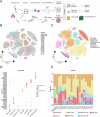

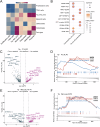
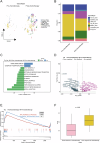
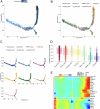
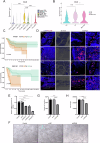

Similar articles
-
Single-cell analysis of multiple cancer types reveals differences in endothelial cells between tumors and normal tissues.Comput Struct Biotechnol J. 2022 Dec 30;21:665-676. doi: 10.1016/j.csbj.2022.12.049. eCollection 2023. Comput Struct Biotechnol J. 2022. PMID: 36659929 Free PMC article.
-
Single-cell and spatial transcriptomics reveal metastasis mechanism and microenvironment remodeling of lymph node in osteosarcoma.BMC Med. 2024 May 17;22(1):200. doi: 10.1186/s12916-024-03319-w. BMC Med. 2024. PMID: 38755647 Free PMC article.
-
MCAM is associated with metastasis and poor prognosis in osteosarcoma by modulating tumor cell migration.J Clin Lab Anal. 2022 Feb;36(2):e24214. doi: 10.1002/jcla.24214. Epub 2021 Dec 27. J Clin Lab Anal. 2022. PMID: 34961985 Free PMC article.
-
Understanding the role of endothelial cells in brain tumor formation and metastasis: a proposition to be explored for better therapy.J Natl Cancer Cent. 2023 Aug 6;3(3):222-235. doi: 10.1016/j.jncc.2023.08.001. eCollection 2023 Sep. J Natl Cancer Cent. 2023. PMID: 39035200 Free PMC article. Review.
-
How the NOTCH pathway contributes to the ability of osteosarcoma cells to metastasize.Cancer Treat Res. 2009;152:479-96. doi: 10.1007/978-1-4419-0284-9_28. Cancer Treat Res. 2009. PMID: 20213410 Review.
Cited by
-
Chromoanagenesis in Osteosarcoma.Biomolecules. 2025 Jun 7;15(6):833. doi: 10.3390/biom15060833. Biomolecules. 2025. PMID: 40563473 Free PMC article. Review.
-
Deciphering spatially confined immune evasion niches in osteosarcoma with 3-D spatial transcriptomics: a literature review.Front Oncol. 2025 Jul 16;15:1640645. doi: 10.3389/fonc.2025.1640645. eCollection 2025. Front Oncol. 2025. PMID: 40740859 Free PMC article. Review.
-
Immune-Modulating Dual-Targeted Nanomaterials for Low-Temperature Photothermal-Photodynamic-Chemodynamic Therapy of Osteosarcoma Targeting Tumor and Endothelial Cells.ACS Nano. 2025 Sep 2;19(34):30786-30809. doi: 10.1021/acsnano.5c00223. Epub 2025 Aug 20. ACS Nano. 2025. PMID: 40834268 Free PMC article.
References
-
- Meltzer, P. S. & Helman, L. J. New Horizons in the Treatment of Osteosarcoma. N. Engl. J. Med. 385, 2066–2076 (2021). - PubMed
-
- Brown, H. K., Tellez-Gabriel, M. & Heymann, D. Cancer stem cells in osteosarcoma. Cancer Lett.386, 189–195 (2017). - PubMed
-
- Chen, C. et al. Immunotherapy for osteosarcoma: Fundamental mechanism, rationale, and recent breakthroughs. Cancer Lett.500, 1–10 (2021). - PubMed
LinkOut - more resources
Full Text Sources

